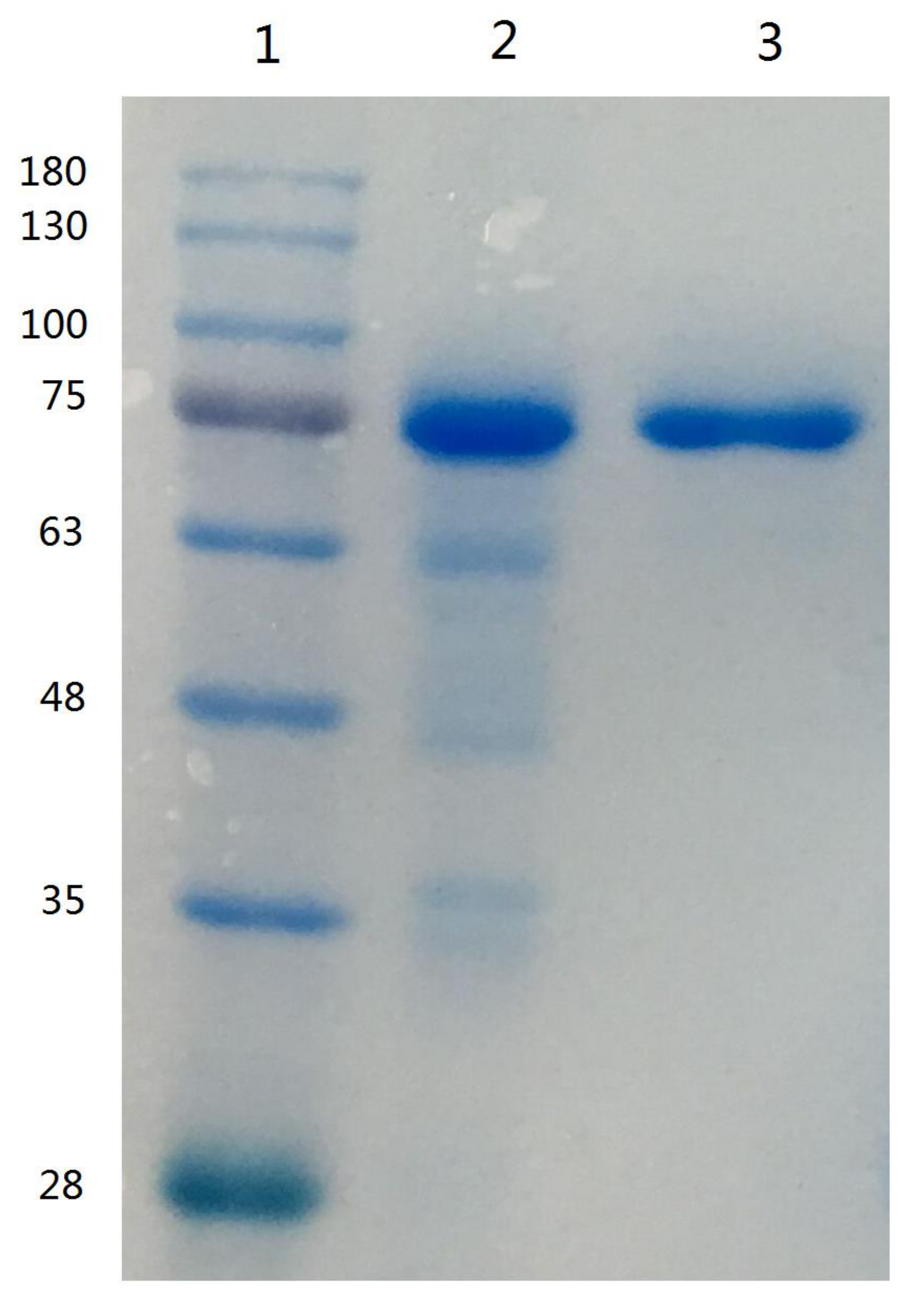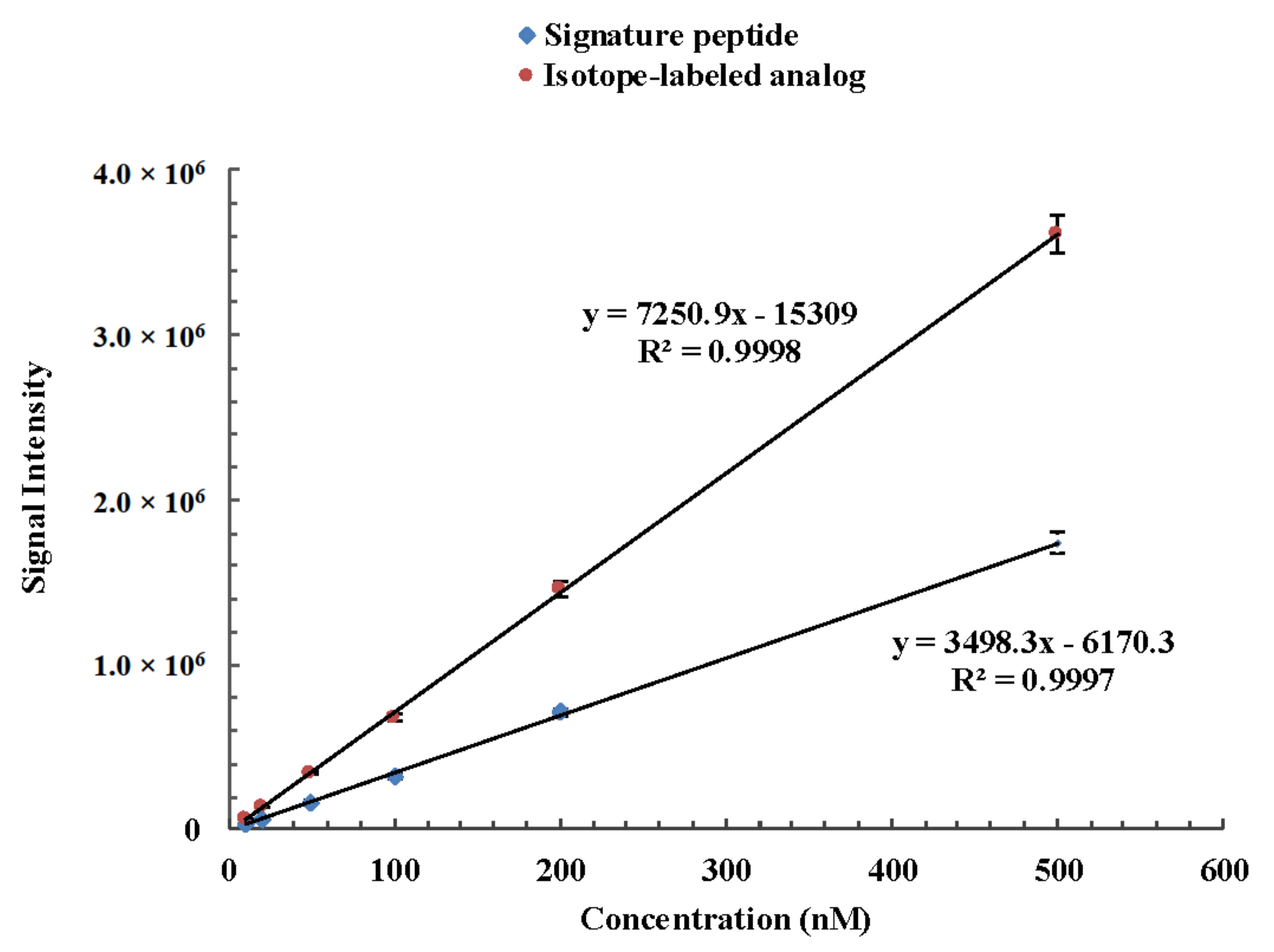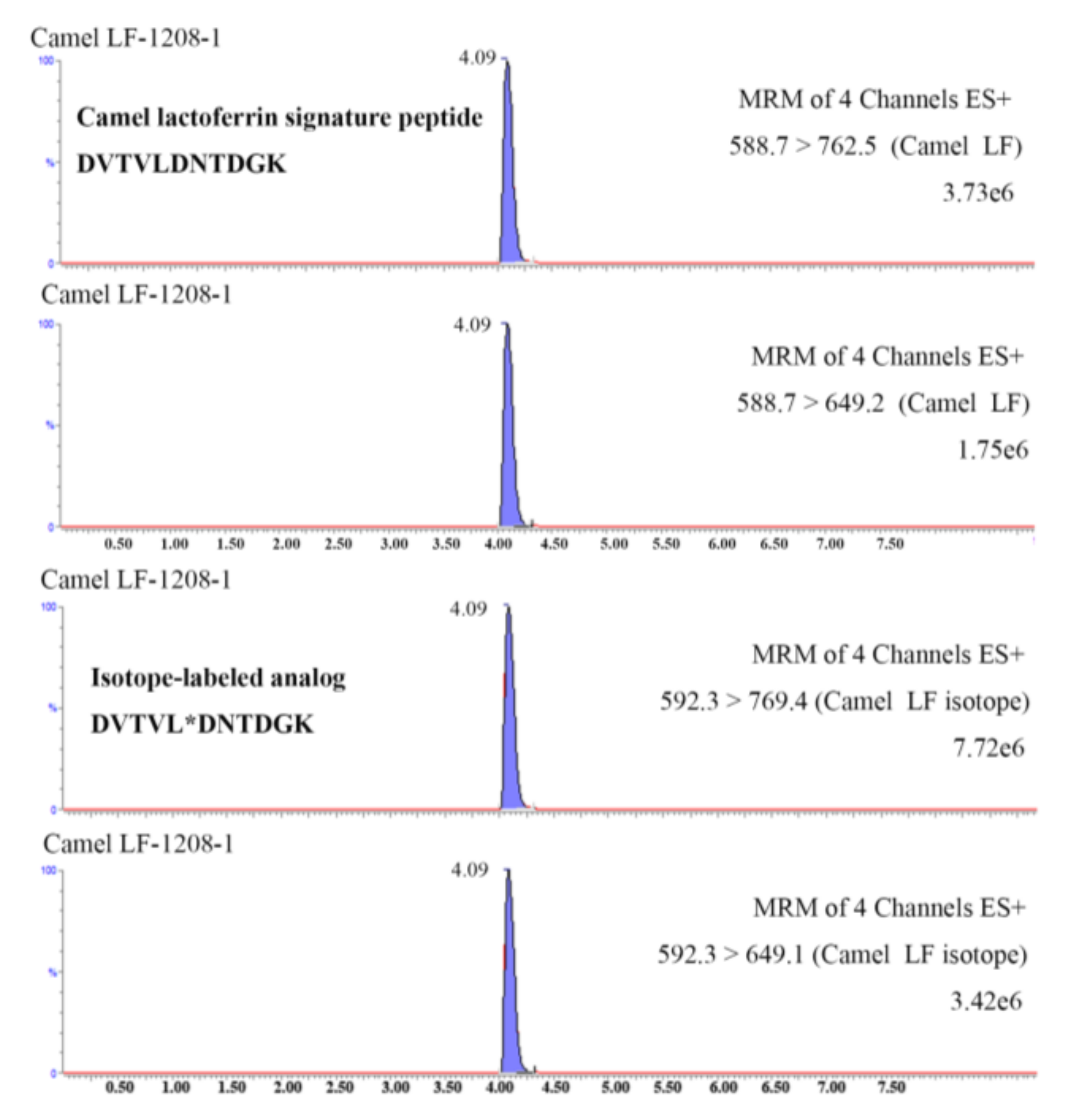Determination of Lactoferrin in Camel Milk by Ultrahigh-Performance Liquid Chromatography-Tandem Mass Spectrometry Using an Isotope-Labeled Winged Peptide as Internal Standard
Abstract
1. Introduction
2. Results and Discussion
2.1. Purification of Camel Lactoferrin
2.2. Selection and Synthesis of Signature Peptide Standard for Camel Lactoferrin
2.3. Optimization and Synthesis of Isotopically Labeled Signature Peptide and Internal Standard
2.4. Method Validation
2.4.1. Specificity
2.4.2. Linearity, Sensitivity, and Repeatability
2.4.3. Recovery and Precision
2.5. Method Application
3. Materials and Methods
3.1. Materials
3.2. Synthetic Peptide Standards
3.3. Purification of Camel Lactoferrin
3.4. Electrophoresis
3.5. Preparation of Tryptic Hydrolysates
3.6. Liquid Chromatography
3.7. Mass Spectrometry
3.8. Method Validation
4. Conclusions
Author Contributions
Funding
Acknowledgments
Conflicts of Interest
References
- Sorensen, M.; Sorensen, S.P.L. The proteins in whey. C. R. Trav. Lab. Carlsberg 1939, 23, 55–99. [Google Scholar]
- Johanson, B. Isolation of an iron-containing red protein from milk. Acta Chem. Scand. 1960, 14, 510–512. [Google Scholar] [CrossRef]
- Stefan, R.; Kappeler, M.A.; Farah, Z.; Puhan, Z. Sequence analysis of camel (Camelus dromedarius) lactoferrin. Int. Dairy J. 1999, 9, 481–486. [Google Scholar]
- Levay, P.F.; Viljoen, M. Lactoferrin: A general review. Haematologica 1995, 80, 252–267. [Google Scholar] [PubMed]
- Moore, S.A.; Anderson, B.F.; Groom, C.R.; Haridas, M.; Baker, E.N. Three-dimensional structure of diferric bovine lactoferrin at 2.8 A resolution. J. Mol. Biol. 1997, 274, 222–236. [Google Scholar] [CrossRef] [PubMed]
- González-Chávez, S.A.; Arévalo-Gallegos, S.; Rascón-Cruz, Q. Lactoferrin: Structure, function and applications. Int. J. Antimicrob. Agents 2009, 33, e1–e301. [Google Scholar] [CrossRef]
- Wakabayashi, H.; Yamauchi, K.; Takase, M. Lactoferrin research, technology and applications. Int. Dairy J. 2006, 16, 1241–1251. [Google Scholar] [CrossRef]
- Habib, H.M.; Ibrahim, W.H.; Schneider-Stock, R.; Hassan, H.M. Camel milk lactoferrin reduces the proliferation of colorectal cancer cells and exerts antioxidant and DNA damage inhibitory activities. Food Chem. 2013, 141, 148–152. [Google Scholar] [CrossRef] [PubMed]
- Almehdar, H.A.; El-Baky, N.A.; Alhaider, A.A.; Almuhaideb, S.A.; Alhaider, A.A.; Albiheyri, R.S.; Uversky, V.N.; Redwan, E.M. Bacteriostatic and Bactericidal Activities of Camel Lactoferrins Against Salmonella enterica Serovar Typhi. Probiotics Antimicrob. Proteins 2019. [Google Scholar] [CrossRef]
- Rasheed, N.R.A.A.Z. Lactoferrin from Camelus dromedarius Inhibits Nuclear Transcription Factor-kappa B Activation, Cyclooxygenase-2 Expression and Prostaglandin E2 Production in Stimulated Human Chondrocytes. Pharmacogn. Res. 2016, 8, 135–141. [Google Scholar] [CrossRef]
- Samarasinghe, R.M.; Kanwar, R.K.; Kanwar, J.R. The effect of oral administration of iron saturated-bovine lactoferrin encapsulated chitosan-nanocarriers on osteoarthritis. Biomaterials 2014, 35, 7522–7534. [Google Scholar] [CrossRef] [PubMed]
- Zhang, J.; Lai, S.; Cai, Z.; Chen, Q.; Huang, B.; Ren, Y. Determination of bovine lactoferrin in dairy products by ultra-high performance liquid chromatography-tandem mass spectrometry based on tryptic signature peptides employing an isotope-labeled winged peptide as internal standard. Anal. Chim. Acta 2014, 829, 33–39. [Google Scholar] [CrossRef] [PubMed]
- El-Gawad, I.A.; El-Sayed, E.M.; Mahfouz, M.B.; Abd El-Salam, A.M. Changes of Lactoferrin concentration in colostrum and milk from different species. Egypt J. Dairy Sci. 1996, 24, 297–308. [Google Scholar]
- Konuspayeva, G.; Faye, B.; Loiseau, G.; Levieux, D. Lactoferrin and Immunoglobulin Contents in Camel’s Milk (Camelus bactrianus, Camelus dromedarius, and Hybrids) from Kazakhstan. J. Dairy Sci. 2007, 90, 38–46. [Google Scholar] [CrossRef]
- Elagamy, E.I. Effect of heat treatment on camel milk proteins with respect to antimicrobial factors: A comparison with cows’ and buffalo milk proteins. Food Chem. 2000, 68, 227–232. [Google Scholar] [CrossRef]
- El-Hatmi, H.; Girardet, J.-M.; Gaillard, J.-L.; Yahyaoui, M.H.; Attia, H. Characterisation of whey proteins of camel (Camelus dromedarius) milk and colostrum. Small Rumin. Res. 2007, 70, 267–271. [Google Scholar] [CrossRef]
- FAO. Whole Fresh Camel Milk Production Quantity. Available online: http://www.fao.org/faostat/en/#data/QL (accessed on 9 October 2019).
- El-Hatmi, H.; Levieux, A.; Levieux, D. Camel (Camelus dromedarius) immunoglobulin G, alpha-lactalbumin, serum albumin and lactoferrin in colostrum and milk during the early post partum period. J. Dairy Res. 2006, 73, 288–293. [Google Scholar] [CrossRef]
- Bokkhim, H.; Bansal, N.; Grondahl, L.; Bhandari, B. Physico-chemical properties of different forms of bovine lactoferrin. Food Chem. 2013, 141, 3007–3013. [Google Scholar] [CrossRef]
- Du, Q.Y.; Lin, D.Q.; Zhang, Q.L.; Yao, S.J. An integrated expanded bed adsorption process for lactoferrin and immunoglobulin G purification from crude sweet whey. J. Chromatogr. 2014, 947–948, 201–207. [Google Scholar] [CrossRef]
- Nowak, P.; Spiewak, K.; Brindell, M.; Wozniakiewicz, M.; Stochel, G.; Koscielniak, P. Separation of iron-free and iron-saturated forms of transferrin and lactoferrin via capillary electrophoresis performed in fused-silica and neutral capillaries. J. Chromatogr. A 2013, 1321, 127–132. [Google Scholar] [CrossRef]
- Zhang, Y.; Luo, J.; Zhang, S.; Bai, Q.; Li, Z.; Li, Q.; Liu, Y.; Zhang, G.; Ma, G.; Su, Z. Selection of downstream steps by analysis of protein surface property: A case study for recombinant human lactoferrin purification from milk of transgenic cow. Process Biochem. 2015, 50, 1441–1448. [Google Scholar] [CrossRef]
- Ren, Y.; Han, Z.; Chu, X.; Zhang, J.; Cai, Z.; Wu, Y. Simultaneous determination of bovine alpha-lactalbumin and beta-lactoglobulin in infant formulae by ultra-high-performance liquid chromatography-mass spectrometry. Anal. Chim. Acta 2010, 667, 96–102. [Google Scholar] [CrossRef] [PubMed]
- Lutter, P.; Parisod, V.; Weymuth, H. Development and validation of a method for the quantification of milk proteins in food products based on liquid chromatography with mass spectrometric detection. J. Aoac Int. 2011, 94, 1043–1059. [Google Scholar] [PubMed]
- Zhang, J.; Lai, S.; Zhang, Y.; Huang, B.; Li, D.; Ren, Y. Multiple reaction monitoring-based determination of bovine alpha-lactalbumin in infant formulas and whey protein concentrates by ultra-high performance liquid chromatography-tandem mass spectrometry using tryptic signature peptides and synthetic peptide standards. Anal. Chim. Acta 2012, 727, 47–53. [Google Scholar] [PubMed]
- Bläckberg, L.; Hernell, O. Isolation of lactoferrin from human whey by a single chromatographic step. Febs Lett. 1980, 109, 180–184. [Google Scholar] [CrossRef]
- Al-Mashikhi, S.; Nakai, S. Isolation of Bovine Immunoglobulins and Lactoferrin from Whey Proteins by Gel Filtration Techniques. J. Dairy Sci. 1987, 70, 2486–2492. [Google Scholar] [CrossRef]
- Al haj, O.A.; Al Kanhal, H.A. Compositional, technological and nutritional aspects of dromedary camel milk. Int. Dairy J. 2010, 20, 811–821. [Google Scholar] [CrossRef]
- Kushnir, M.M.; Rockwood, A.L.; Roberts, W.L.; Abraham, D.; Hoofnagle, A.N.; Meikle, A.W. Measurement of thyroglobulin by liquid chromatography-tandem mass spectrometry in serum and plasma in the presence of antithyroglobulin autoantibodies. Clin. Chem. 2013, 59, 982–990. [Google Scholar] [CrossRef]
- Gerber, S.A.; Rush, J.; Stemman, O.; Kirschner, M.W.; Gygi, S.P. Absolute quantification of proteins and phosphoproteins from cell lysates by tandem MS. Proc. Natl. Acad. Sci. United States Am. 2003, 100, 6940–6945. [Google Scholar] [CrossRef]
Sample Availability: Samples of the compounds are not available from the authors. |




| Original Level (mg/100 g) | Spiked Level (mg/100 g) | Determined Level (mg/100 g) | Recovery Rate (%) | RSD% |
|---|---|---|---|---|
| 6.2 ± 0.5 | 6.0 | 10.6 ± 0.3 | 74.5 ± 5.7 | 7.7 |
| 29.3 ± 1.0 | 30.0 | 60.4 ± 2.3 | 103.6 ± 7.6 | 7.3 |
| 65.1 ± 4.5 | 60.0 | 123.4 ± 3.6 | 97.1 ± 6.0 | 6.4 |
© 2019 by the authors. Licensee MDPI, Basel, Switzerland. This article is an open access article distributed under the terms and conditions of the Creative Commons Attribution (CC BY) license (http://creativecommons.org/licenses/by/4.0/).
Share and Cite
Li, X.; Li, Z.; Xu, E.; Chen, L.; Feng, H.; Chen, L.; Deng, L.; Guo, D. Determination of Lactoferrin in Camel Milk by Ultrahigh-Performance Liquid Chromatography-Tandem Mass Spectrometry Using an Isotope-Labeled Winged Peptide as Internal Standard. Molecules 2019, 24, 4199. https://doi.org/10.3390/molecules24224199
Li X, Li Z, Xu E, Chen L, Feng H, Chen L, Deng L, Guo D. Determination of Lactoferrin in Camel Milk by Ultrahigh-Performance Liquid Chromatography-Tandem Mass Spectrometry Using an Isotope-Labeled Winged Peptide as Internal Standard. Molecules. 2019; 24(22):4199. https://doi.org/10.3390/molecules24224199
Chicago/Turabian StyleLi, Xia, Zengmei Li, Enmin Xu, Ling Chen, Hua Feng, Lu Chen, Ligang Deng, and Dongliang Guo. 2019. "Determination of Lactoferrin in Camel Milk by Ultrahigh-Performance Liquid Chromatography-Tandem Mass Spectrometry Using an Isotope-Labeled Winged Peptide as Internal Standard" Molecules 24, no. 22: 4199. https://doi.org/10.3390/molecules24224199
APA StyleLi, X., Li, Z., Xu, E., Chen, L., Feng, H., Chen, L., Deng, L., & Guo, D. (2019). Determination of Lactoferrin in Camel Milk by Ultrahigh-Performance Liquid Chromatography-Tandem Mass Spectrometry Using an Isotope-Labeled Winged Peptide as Internal Standard. Molecules, 24(22), 4199. https://doi.org/10.3390/molecules24224199




